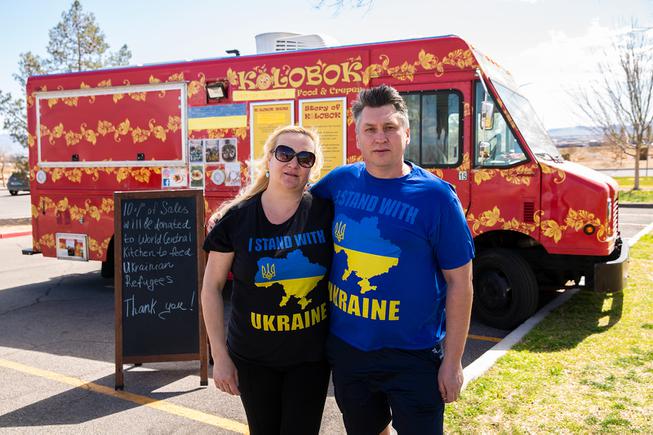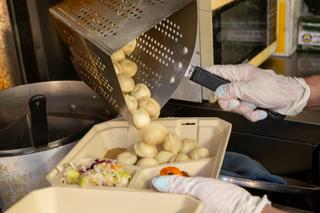
Ellen Doren and Bulat Nasybulin pose for a photo in front of thier Eastern European food truck Wed. March 16, 2022. 10% of their sales will be donated to World Central Kitchen to help feed Ukrainian refugees.
Friday, March 25, 2022 | 2 a.m.
Ellen Doren and Bulat Nasybulin donned matching shirts with vibrant blue and yellow colors and a stark, now familiar, message: “I Stand With Ukraine.”
The Las Vegas couple are the co-owners of the Kolobok food truck, where 10% of their profits are sent every two weeks to Ukrainian refugee causes to effect change from the United States.
Doren and Nasybulin, both 46, grew up in Russia and Ukraine, respectively. Doren’s grandmother, who lives with the couple in Las Vegas, is also from Ukraine, from which she evacuated during World War II.
With roots in both countries, the couple said the decision to donate was barely a conversation: How could they not help, they questioned, when their own friends and family members were protesting in Russia, fleeing to Poland or seeing their home break down around them?
“We were shocked because (we have) half of our family, relatives and best friends in Ukraine,” said Nasybulin, who also lived in Moscow. “I spent my childhood in Ukraine. I studied (the) Ukrainian language in school.”
Their initial donation of $1,000 was sent to World Central Kitchen, a not-for-profit organization created by celebrity chef José Andrés that feeds refugees in natural disasters or refugee crises.
World Central Kitchen has a kitchen and food supply depot on the Poland-Ukraine border. It also supports restaurants to serve food in cities being attacked, like Kharkiv and Kyiv, as well as fills trucks at warehouses in Lviv that send food to the Ukrainian cities Odessa and Mykolayiv.
The organization reported March 12 that it had served one million meals for Ukrainians and Ukrainian refugees through its #ChefsForUkraine program across more than 55 cities and over 330 distribution points.
“I’ve known this organization for a long time,” Doren said. “I’ve heard about it when (Hurricane) Katrina actually happened in the U.S., and so many chefs that I knew personally went to help out.”
Kolobok serves classic Eastern European dishes like golubtsi, or stuffed cabbage rolls; pelmeni, or beef and pork dumplings with jalapeño cabbage salad; and a hot-and-spicy tomato dip called adjika.
The truck's bright red-and-yellow exterior is easily spotted as it sets up outside local breweries or at events like First Fridays in the downtown Las Vegas Arts District.
It has been four years since they opened the food truck, which launched in the Bay Area and derives its name from Russian folklore.
When Doren and Nasybulin moved to Las Vegas last year, it was like they had opened their business for the first time, having to reintroduce customers to culture and food — an experience that has yielded intimate conversations about the ongoing conflict with local Russians and Ukrainians who are customers of the truck.
The consensus: The conflict must stop.
“We felt like this could be a good way to introduce the community to Russia,” Doren said. “(Customers) are very supportive of our efforts.”
Overcoming perceptions
The war in Ukraine, as well public attitudes toward Russians, is affecting Kolobok’s business as a Russian food truck, the couple said.
Even though the owners firmly stand with Ukraine, outsiders may not realize their stance, they said, especially with “Russian” emblazoned on the exterior of the truck to indicate the type of food it serves.
They were expected to set-up shop over multiple weekends at a craft festival in Las Vegas this spring, but organizers first asked them to change the outward appearance of their truck and rebrand as Eastern European food before requesting they no longer participate, citing safety concerns to Doren and Nasybulin but also to the other food truck vendors. The show’s organizers declined to comment.
“I kept asking, ‘What do you mean by security?’, and (the representative) said, there are lots of crazy people out there. It only takes one.’” Doren said. “The food is the same. Our heart and soul is the same. So we’ll continue providing delicious food.”
Before eating Doren and Nasybulin’s cabbage rolls and dumplings Friday on Water Street in Henderson, resident Stephen Galbraith said he previously had not heard of the food truck. But upon learning of the co-owners’ donations that evening, he said he would seek them out again. The truck gives the area variety, Galbraith said, with its “great portions and wonderful food.”
“I know that we can be discriminatory at times, and right now, this country is not inclined pleasantly towards Russia,” Galbraith said. “I don’t want immigrants treated that way here.”
Regional cuisine
The intersection of Ukrainian and Russian foods is, like most overlapping cuisines, based on each region’s geography, climate, local indigenous animals and plants, religion, topography and socioeconomics, said Christine Bergman, UNLV professor of food, science and nutrition.
As a result, there is no all-encompassing “Russian cuisine,” but rather sub cuisines per location, Bergman said. In the U.S., people on the East Coast may not eat the same foods as residents in Southern states. The same applies to people in Siberia, who eat different foods than Russians situated closer to Ukraine, she said.
One dish with both Russian and Ukrainian roots is borscht, a beet-based soup on Kolobok’s menu. While Siberian borscht typically includes sauerkraut, western Russians and Ukrainians will use plain cabbage. The sauerkraut makes the sour soup more acidic and used, Bergman said, likely because Siberians, with their short summers, often pickle their vegetables so the food can persist in quality throughout the frigid winters.
Some Ukrainians may put sauerkraut in their borscht, “but they seldom do in comparison to the people in Siberia,” Bergman said.
Bergman grew up eating her Ukrainian grandmother’s dishes, like the eggplant spread ikra served on crostinis, a crusty bread. The dish is one Bergman still serves at dinner parties, she said.
And while her friends ate oatmeal for breakfast, Bergman said she remembered eating kasha, made from buckwheat and mixed with sour cream, honey and salt. Or else she ate blintzes, a thin filled pancake with Jewish origins that resembles Russian blinis, while her American friends had fluffy pancakes and maple syrup.
“Each family, you know, has their own riff on differences,” she said. “Everybody eats stuffed cabbage rolls, but some families put pork in it and onions, and others put ground beef. That kind of thing. ... Similar, but different.”

